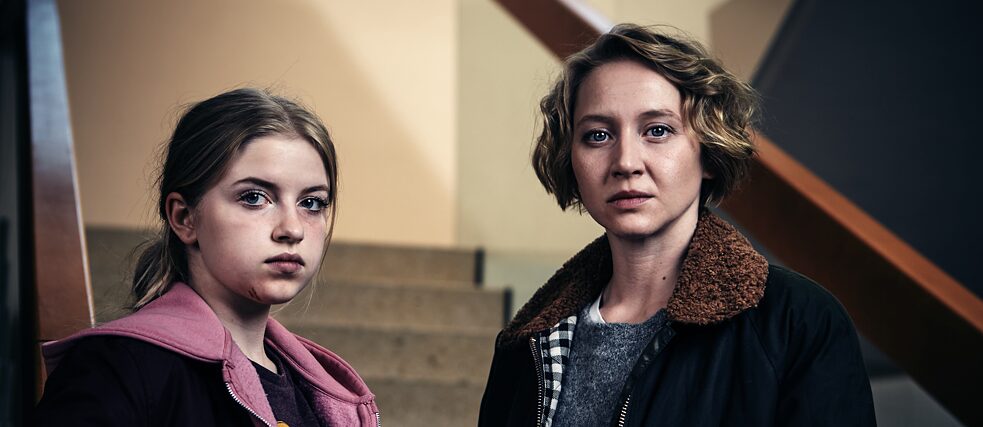German Series in India
Woman of the Dead

© Mona Film/ Barry Films/ Stephan Burchardt
Fans of Nordic noir will feel right at home with Netflix’s Totenfrau (a.k.a. Woman of the Dead), a six-part thriller set in Austria’s Tyrolean Alps. The chilly ambiance here stems from more than just the climate. A picturesque mountain town conceals a criminal underworld that takes rich-guy privilege way past corruption into grotesque depravity, while the heroine is something of a sociopath herself, more comfortable communing with the dead than with human interaction. In this kind of crime thriller, trauma and psychoses make the world go round.
By Josef Markus
You want it darker
Based on a mystery novel by Bernd Aichner, Totenfrau follows the mortician Brünhilde Blum (Anna-Maria Mühe), who is married to Mark (Maximilian Kraus), a cool, easygoing police officer. They live with their two kids in a small town outside Innsbruck, where the owners of the local ski resort are the true power. When Mark is killed in a hit-and-run one morning, his fellow cops are weirdly uninterested in pursuing the leads, but Blum starts digging, and digging.Mark’s death opens up a fissure in Blum’s life. Elliptical flashbacks reveal that she was the adopted child of two morticians who moonlighted as sadists: their favored method of disciplining their daughter was to seal her in a coffin. The young Blum began to hear the corpses in her parents’ morgue speaking to her, offering her soothing counsel.
Even today, the adult Blum vibes with the recently deceased when no one else is around. Mark was her tether to the real world, her light, and with his murder, Blum’s inner darkness resurfaces. Her sense of injustice becomes a blunt instrument, to be wielded against anyone in her way.
The horror, the horror
A co-production between Netflix and Austria’s ORF network, Totenfrau is part of a recent wave of German-language crime serials set in remote mountain towns. Call it “Alpine noir,” where the producers are out to make viewers forget any pleasant notions they might have of quaintly rustic vacation spots. In these idyllic locales there is no shortage of mayhem going on. Swiss TV has contributed four somber seasons of Wilder, and, beating Totenfrau to the airwaves by just two months, Germany has Höllgrund, set in a Black Forest town. Perhaps someone is proposing a dark and gritty reboot of Heidi even now.Totenfrau and Höllgrund both highlight the victimization of migrants in isolated mountain communities. The locals do not want the 21st century arriving on their doorsteps, but come it must, and only the young heroines of each series understand that.
Both shows also lean into the creepier side of a dark crime thriller, flirting with horror. Blum of course converses with dead people, and the policewoman lead in Höllgrund is regularly visited by the ghost of her late father, who delivers caustic assessments of her progress in solving his murder.
In each case, the show preserves an element of ambiguity — we understand that the dialogues take place in the protagonists’ heads. But edging into the uncanny may be a sign that realism is inadequate for depicting the pathologies loose in the world today. Or maybe it’s just a sign that even in German-language TV, the standard crime show formulas are played out, and the format needs shaking up, especially if the TV networks are going to draw the eyeballs of younger audiences.
#MeToo, with bloodshed
To unravel the conspiracy behind her husband’s murder, Totenfrau’s Blum has to find her inner femme fatale. Her targets in the cabal of local power brokers are all men, of course, each one a paradigm of smug privilege. Blum eventually discovers that every institution in her town is compromised, if not rotten to the core.Totenfrau is eminently watchable as each episode breaks out into inventive violence. It also gets a little repetitive, and numbing. The show is well cast: it’s satisfying to watch Anna-Maria Mühe transform into a powerhouse of vengeance, while her adversaries are a study in coolly amoral villainy, silky condescension laced with menace. Among the show’s other rewards are the imaginative opening credits, which are like a series of vintage crime-novel paperback covers come to life. And it’s a blast to rocket along the Alpine roads with Blum on her motorcycle, the camera trailing low behind her.
Eventually,a dreadful flashback in the final episode reveals that the town’s favored sons bonded as teens by committing a truly ugly act of sexual violence in a ski-resort cable car. As entitled middle-aged creeps, they’ve progressed to murdering helpless migrant women (donning animal masks as they do so, in the show’s most overt horror-movie flourish). Thus as Blum takes them on, one by one, she’s avenging not just her husband’s murder but decades of abuse.
As with Stieg Larsson’s famed Millennium trilogy, it’s not hard to read Totenfrau as social critique in the guise of blood-soaked pulp fiction. A damaged heroine will rise, Taser in hand, to tear down a social order founded on evil white guy dominance. The scenario no doubt felt fresher when Bernhard Aichner’s novel debuted in 2014. Nearly a decade on, though, a viewer can’t help reflecting how perilously close Totenfrau comes to a QAnon narrative. A gang of perverts control everything; if only it were that simple.
Women of the dead (Totenfrau)
Eight episodes, approx. 48 minutes each
Directed by Nicolai Rohde; starring: Anna Maria Mühe, Felix Klare, Yousef Sweid, Gerhard Liebmann
Screenplay after the novel by Bernhard Aichner by Barbara Stepansky, Wolfgang Mueller, Benito Mueller, Mike Majzen und Nicolai Rohde. Original Score by Patrick Kirst
Produced by Barry Films / Mona Film Produktion for Netflix / ORF
Watch “Woman of the Dead”
Worldwide on NETFLIX










